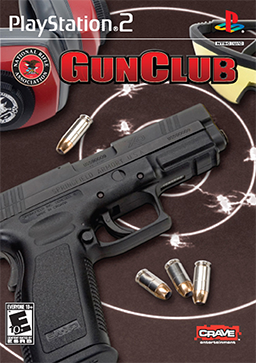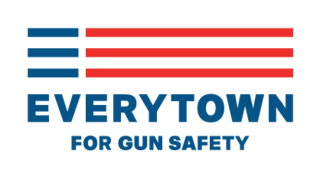
A school shooting is an armed attack at an educational institution, such as a primary school, secondary school, high school or university, involving the use of a firearm. Many school shootings are also categorized as mass shootings due to multiple casualties. The phenomenon is most widespread in the United States, which has the highest number of school-related shootings, although school shootings have taken place elsewhere in the world.

The National Rifle Association of America (NRA) is a gun rights advocacy group based in the United States. Founded in 1871 to advance rifle marksmanship, the modern NRA has become a prominent gun rights lobbying organization while continuing to teach firearm safety and competency. The organization also publishes several magazines and sponsors competitive marksmanship events. According to the NRA, it had nearly 5 million members as of December 2018, though that figure has not been independently confirmed.

Bowling for Columbine is a 2002 Academy Award-winning documentary film written, produced, directed, and narrated by Michael Moore. The film explores what Moore suggests are the primary causes for the Columbine High School massacre in 1999 and other acts of gun violence. He focuses on the background and environment in which the massacre took place and some common public opinions and assumptions about related issues. The film also looks into the nature of violence in the United States, and American violence abroad.

Gun politics is defined in the United States by two primary opposing ideologies concerning the private ownership of firearms. Those who advocate for gun control support increasingly restrictive regulation of gun ownership; those who advocate for gun rights oppose increased restriction, or support the liberalization of gun ownership. These groups typically disagree on the interpretation of the text, history and tradition of the laws and judicial opinions concerning gun ownership in the United States and the meaning of the Second Amendment to the Constitution of the United States. American gun politics involves these groups' further disagreement concerning the role of firearms in public safety, the studied effects of ownership of firearms on public health and safety, and the role of guns in national and state crime.

Wayne Robert LaPierre Jr. is an American gun rights lobbyist who was the CEO and executive vice president of the National Rifle Association (NRA), a position he held between 1991 and 2024.

Active shooter is a term used to describe the perpetrator of an ongoing mass shooting. The term is primarily used to characterize shooters who are targeting victims indiscriminately and at a large scale, who oftentimes, will either commit suicide or intend to be killed by police. More generally, an active perpetrator of a mass murder may be referred to as an active killer.

NRA Gun Club is described as a nonviolent first-person target shooting game by Crave Entertainment in North America and 505 Games only in Italy. Although not released in the UK, a few PAL UK units have been found in circulation in some 505 European markets. The game allows gamers to enter the shooting range and shoot at paper targets, watermelons and sporting clays. The game contains over 100 licensed and recreated firearms. It was endorsed by the National Rifle Association of America, bearing their logo on the cover art.

Gun violence is a term of political, economic and sociological interest referring to the tens of thousands of annual firearms-related deaths and injuries occurring in the United States. In 2022, up to 100 daily fatalities and hundreds of daily injuries were attributable to gun violence in the United States. In 2018, the most recent year for which data are available, the Centers for Disease Control and Prevention's (CDC) National Center for Health Statistics reported 38,390 deaths by firearm, of which 24,432 were suicides. The national rate of firearm deaths rose from 10.3 people for every 100,000 in 1999 to 11.9 people per 100,000 in 2018, equating to over 109 daily deaths. In 2010, there were 19,392 firearm-related suicides, and 11,078 firearm-related homicides in the U.S. In 2010, 358 murders were reported involving a rifle while 6,009 were reported involving a handgun; another 1,939 were reported with an unspecified type of firearm. In 2011, a total of 478,400 fatal and nonfatal violent crimes were committed with a firearm.

Everytown for Gun Safety is an American nonprofit organization which advocates for gun control and against gun violence. Everytown was formed in 2013 due to a merger between Mayors Against Illegal Guns and Moms Demand Action for Gun Sense in America.
Giffords is an American advocacy and research organization focused on promoting civilian disarmament. The organization draws its name from one of its co-founders, Gabby Giffords, a former Democratic member of the U.S. House of Representatives. Rep. Giffords was shot along with 18 others at a constituent meeting in Tucson in 2011. The organization has three parts: a 501(c)(4) lobbying arm, a 501(c)(3) research arm, and a super PAC. It was previously known in a different configuration as Americans for Responsible Solutions.

The Sandy Hook Elementary School shooting was a mass shooting that occurred on December 14, 2012, in Newtown, Connecticut, United States, when 20-year-old Adam Lanza shot and killed 26 people. Twenty of the victims were children between six and seven years old, and the other six were adult staff members. Earlier that day, before driving to the school, Lanza fatally shot his mother at their Newtown home. As first responders arrived at the school, Lanza died by suicide, shooting himself in the head.
The December 14, 2012, Sandy Hook Elementary School shooting—in which a gunman shot and killed his mother at home, 20 students, 6 teachers, then himself—received international attention. Governments and world leaders offered their condolences, while tributes and vigils by people were made in honor of the victims. U.S. President Barack Obama gave a televised address on the day of the shootings, saying, "We're going to have to come together and take meaningful action to prevent more tragedies like this, regardless of the politics." Obama paused twice during the address to compose himself and wipe away tears, and expressed "enormous sympathy for families that are affected". He also ordered flags to be flown at half-staff at the White House and other U.S. federal government facilities worldwide in respect for the victims. Three days after the massacre, 151,000 Americans had signed up at the Obama administration's We the People petitioning website in support of a renewed national debate on gun control. Obama attended and spoke at an interfaith vigil on December 16 in Newtown, Connecticut.
After the Sandy Hook Elementary School shooting, multiple gun laws were proposed in the United States at the federal and state levels. The shooting renewed debate about gun control. The debates focused on requiring background checks on all firearm sales, and on passing new and expanded assault weapon and high-capacity magazine bans.

The Assault Weapons Ban of 2013 was a bill introduced in the 113th United States Congress as S. 150 by Senator Dianne Feinstein, D-CA, on January 24, 2013, one month after the Sandy Hook Elementary School shooting. It was defeated in the Senate on April 17, 2013 by a vote of 40 to 60.

Mass shootings are incidents involving multiple victims of firearm related violence. Definitions vary, with no single, broadly accepted definition. One definition is an act of public firearm violence—excluding gang killings, domestic violence, or terrorist acts sponsored by an organization—in which a shooter kills at least four victims. Using this definition, a 2016 study found that nearly one-third of the world's public mass shootings between 1966 and 2012 occurred in the United States, In 2017 The New York Times recorded the same total of mass shootings for that span of years. A 2023 report published in JAMA covering 2014 to 2022, found there had been 4,011 mass shootings in the US, most frequent around the southeastern U.S. and Illinois. This was true for mass shootings that were crime-violence, social-violence, and domestic violence-related. The highest rate was found in the District of Columbia, followed by Louisiana and Illinois.

Public opinion on gun control in the United States has been tracked by numerous public opinion organizations and newspapers for more than 20 years. There have also been major gun policies that affected American opinion in the 1990s. Throughout these polling years, there are different gun control proposals that show promise for bipartisan action. Over the years listed there have been mass shootings, most notably school shootings, that have affected public opinion. There have also been a growth in states around the United States taking more drastic measures on gun control.

Thoughts and prayers is a common phrase frequently used by officials and celebrities, particularly in the United States, as a condolence after an event, such as a deadly natural disaster or mass shooting. The phrase has received significant criticism for its repeated usage in the context of gun violence or terrorism, with critics claiming "thoughts and prayers" are offered as substitutes for action such as effective gun control or counter-terrorism legislation.

On February 14, 2018, 19-year-old Nikolas Cruz opened fire on students and staff at Marjory Stoneman Douglas High School in the Miami suburban town of Parkland, Florida, United States, killing 17 people and injuring 17 others. Cruz, a former student at the school, fled the scene on foot by blending in with other students and was arrested without incident approximately one hour and twenty minutes later in nearby Coral Springs. Police and prosecutors investigated "a pattern of disciplinary issues and unnerving behavior".

The Uvalde school shooting was a mass shooting that occurred on May 24, 2022, at Robb Elementary School in Uvalde, Texas, United States, when 18-year-old Salvador Ramos, a former student at the school, fatally shot 19 students and two teachers, while 17 others were injured but survived. After shooting and severely wounding his grandmother at their home earlier that day, Ramos drove to and entered the school, remaining in an adjoining classroom for more than an hour before members of the United States Border Patrol Tactical Unit fatally shot him after they bypassed numerous local and state officers who had been in the school's hallways for over an hour.
Arming teachers is equipping teachers in preschool through secondary school with firearms with the intent to prevent casualties from school shootings. Such proposals have engendered public debate regarding with whom the responsibility for providing a safe environment lies, and whether it would reduce or escalate the risk of shootings. School shootings, and proposals to arm teachers, are most common in the United States, but proposals have also been made in countries such as Israel, Kenya, Pakistan, South Africa, and Thailand.















